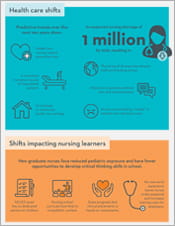A Review of Today’s Learning Landscape: Understanding the Next Generation of Pediatric Clinicians

With cultural, technological and generational shifts affecting pediatric health care education, clinicians' and employers' needs are changing. Staff from Pediatric Learning Solutions (PLS) researched the integration of technology into learning and tactics to promote critical thinking and learning retention. This began with attending webinars, industry conferences and conducting a literature review of resources including:
- "Nurse as Educator: Principles of Teaching and Learning for Nursing Practice 5th Edition" by Susan B. Bastable.
- "The Future of Nursing 2020-2030: Charting a Path to Achieve Health Equity, a Consensus Study Report."
- Additional books and journal articles linked throughout this article.
After initial research, the PLS team led focus groups with educators from 16 children's hospitals in June of 2022. Discussions included the challenges and opportunities they are facing in educating their staff, changes in the learning landscape, and potential solutions going forward. This article explores the key themes from this combined research effort.
A changing dynamic
Nursing schools have always focused education heavily on the adult patient population, as they are the majority of the patients in the health care system. In recent years, the National Council Licensure Examination (NCLEX) has also shifted to focusing on lifespan diseases with no dedicated section on children.
This has left new graduate nurses entering pediatric care settings underprepared, and it leaves their employers with the responsibility of training staff to care for their young patients competently and confidently.
The pediatric health care knowledge gap is also heightened by a shift to preventive care across the health care setting, meaning hospitalized patients are higher acuity and with more complex conditions than in the past. These patients require a higher level of communication, teamwork and knowledge from the clinicians caring for them.
By 2026, the Bureau of Labor Statistics predicts a shortage of over 1 million nurses in the United States. This shortage will likely lead to hiring more international staff and a sense of urgency to get new nurses to the bedside. An increasingly internationally diverse staff can result in challenges from communication barriers, differences in care standards between countries, and more.
This shift in the workforce, changing educational practices, and new employees' learning preferences, will require educators and employers to adjust their onboarding and training strategies with additional layers of education, training, and team building needed to create cohesive, competent teams providing high-quality patient care.
Understanding today's new pediatric nurses
In the PLS Learning Landscape Task Force discussion groups, educators across the country shared they have noticed characteristics that separate recent classes of new graduate nurses from their predecessors. Many of these differences seem to stem from the strong influence technology has played in their lives.
"I've heard the term 'blink generation' [used to describe them] because they're used to being able to pull up a YouTube video, watch 30 seconds of it and learn how to do [something]" Dennis Ward, ULearn Administrator at Cook Children's Health Care System, says. "With health care, unfortunately, it's not quite that simple."
Educators have also said they've noticed deficits in communication skills, likely attributed to a combination of technology and the effects of the Covid-19 pandemic, which limited opportunities for hands-on and in-person learning.
"Technology has done future generations such a disservice because when they wanted to say something, they would [often] say it in a text," Melinda Pascual, BSN, RN, CPN, manager of Clinical Education and Professional Development at Children's Hospital of Orange County (CHOC) says. "It's the same thing with education. [Learners] say, 'I want to know all of this stuff, and I want to know it by tomorrow,' and I say, 'That's great. I love your initiative, [so] let's talk about where you are and how we can get you to where you want to be.'"
While the new generations have different learning preferences, they are entering the workforce with stronger skills than their predecessors in some areas. They are comfortable with online learning and want to identify and fill gaps in their own knowledge. They also have high expectations for their own performance and they want to have a positive effect on the world.
The challenge for educators is providing the groundwork new clinicians need to retain them for the long-term. Gaps in nursing education, technology, and the impact the pandemic have contributed to high anxiety and stress levels, lack of critical thinking skills, and lowered competence and confidence on the job—all of which lead to burnout and increased turnover rates.
Adjusting to meet learners' needs
The traditional educational ecosystem consisting of course assignments, post-assessments, printable performance support, and static resources are not meeting the needs of today's clinicians. Educators have strategized how to better support the next generation of pediatric clinicians. This includes rethinking training delivery methods, embracing evolving technologies, and delivering accessible resources with a focus on facilitating clinical judgement.
New trends in learning technologies and methodologies can help with providing education in a way that works well for today's learners' needs:
- Adaptive learning. A personalized approach to smaller skills. Gaining specific pieces of knowledge allows learners to focus on their personal gaps, improve knowledge retention, and speed up competency development.
- Immersive learning. Case-presentation-based learning simulations with hands-on practice opportunities and built-in time for self-reflection and group discussion to promote communication skills and critical thinking.
- App usage. Serves as a supplement to full education methods and can provide practice opportunities as well as on-the-job performance support.
- Gaming. Group activities help tap into employee motivation to train on soft skills, specific procedures, and more.
Integrating innovative teaching methods with additional adjustments can help meet learners where they are and guide them toward competence in providing quality patient-centered care.
Changes that have shown effective include:
- Increased frequency of learning opportunities.
- Smaller, "bite size" learning opportunities.
- Opportunities to integrate their knowledge into practice.
- Positive feedback over criticism whenever possible.
- Providing a sense of impact where possible and as early as possible.
While the factors that led to challenges in educating today's nurses are multifaceted, the reasons most join the field are likely the same across generations. Nurses care for, and about, other people. Hospitals need to look not only to the trending learning technologies, but to creating space for forming human connections.
In an environment that can seem overwhelming and out of control for new nurses, Pascual has guided CHOC in developing a phased education program that integrates learning tools such as PLS with opportunities for personal connections early in the process.
"We felt like we can give learners some power by letting them be a mentor to the group right after them," Pascual says. "They're in it together, but because of the experiences they have had, they're able to give advice and be that human connection for our program."
About PLS
Pediatric Learning Solutions’ online education provides the foundational knowledge clinicians need to master the competencies and skills for safe and effective patient care.



